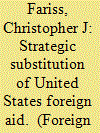| Srl | Item |
| 1 |
ID:
186757


|
|
|
|
|
| Summary/Abstract |
China's approach to gaining coercive leverage in the limited wars that it has planned to fight against nuclear-armed adversaries differs from the choices of other states. A theory of strategic substitution explains why China relied on threats to use information-age weapons strategically instead of nuclear threats or conventional victories in the post–Cold War era. Information-age weapons (counterspace weapons, large-scale cyberattacks, and precision conventional missiles) promise to provide quick and credible coercive leverage if they are configured to threaten escalation of a conventional conflict using a “brinkmanship” or “calibrated escalation” force posture. China pursued information-age weapons when it faced a leverage deficit, defined as a situation in which a state's capabilities are ill-suited for the type of war and adversary that it is most likely to fight. China's search for coercive leverage to address those defi- cits became a search for substitutes because its leaders doubted the credibility of nuclear threats and were unable to quickly redress a disadvantage in the conventional military balance of power. A review of original Chinese-language written sources and expert interviews shows that China pursued a coercive cyberattack capability to address a leverage deficit after the United States bombed China's embassy in Belgrade in 1999. China's low dependence on information networks shaped its initial choice of a brinkmanship posture for large-scale offensive cyber operations. China switched to a calibrated escalation posture in 2014, following a dramatic increase in its vulnerability to cyberattacks.
|
|
|
|
|
|
|
|
|
|
|
|
|
|
|
|
| 2 |
ID:
095597


|
|
|
|
|
| Publication |
2010.
|
| Summary/Abstract |
I present a foreign policy decision-making theory that accounts for why US food aid is used strategically when other more powerful economic aid tools are at the disposal of policymakers. I focus my analysis on US food aid because this aid program provides an excellent case with which to test for the existence of foreign policy substitution. Substitution is an important assumption of many foreign policy theories yet proves to be an allusive empirical phenomenon to observe. Central to this analysis is the identification of legal mechanisms such as the ''needy people" provision in the US foreign aid legislation that legally restrict certain types of aid; this mechanism, however, does allow for the allocation of certain types of foreign aid, such as food aid, to human rights abusing regimes. Thus, I test if food aid is used as a substitute for human rights abusing states while methodologically accounting for other aid options. The empirical results, estimated with a multinomial logit and Heckman model, demonstrate that countries with high levels of human rights abuse are (i) more likely to receive food aid and (ii) receive greater amounts of food aid even when controlling for other economic aid, the conditioning effect of strategic interests and humanitarian need over the period 1990-2004.
|
|
|
|
|
|
|
|
|
|
|
|
|
|
|
|